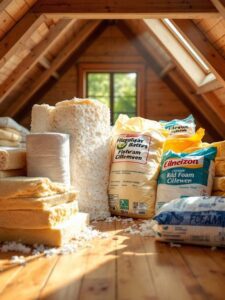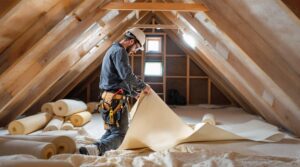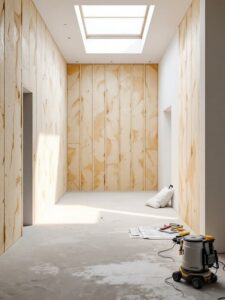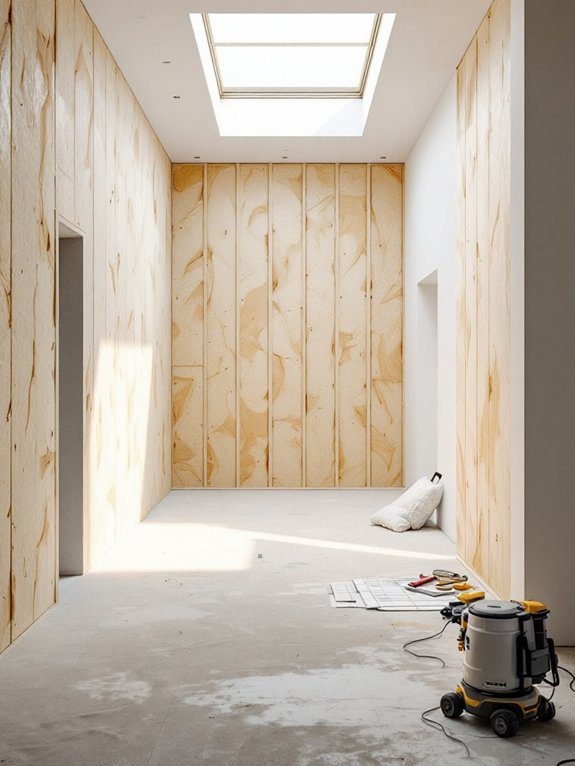To choose the right external wall insulation installer, you'll need to verify their PAS 2030 certification and registration with key industry bodies like INCA and NIA. Check for BBA certification, TrustMark registration, and insurance-backed warranties through SWIGA. Examine their portfolio of similar projects, request detailed case studies, and verify their professional indemnity insurance. A thorough site assessment and understanding of thermal performance calculations will indicate their technical expertise. The following detailed criteria will help guarantee your installation meets UK standards.
Key Takeaways
- Verify installer has PAS 2030 certification and TrustMark registration to ensure they meet government-endorsed quality standards for energy efficiency work.
- Request detailed case studies and references from previous external wall insulation projects completed within the last three years.
- Check comprehensive insurance coverage, including professional indemnity and public liability, along with insurance-backed warranties through schemes like SWIGA.
- Ensure installer conducts thorough site assessments including wall surveys, U-value calculations, and moisture management analysis for your property.
- Confirm materials are BBA-certified and installer demonstrates clear understanding of thermal performance requirements and building regulations.
Professional Certifications and Industry Accreditations

When selecting an installer for external wall insulation (EWI), verifying proper certifications and industry accreditations is essential for guaranteeing quality workmanship and regulatory compliance.
You'll want to confirm that your chosen installer holds PAS 2030 certification, which demonstrates their competency in installing energy efficiency measures.
Check if they're registered with industry-recognized bodies like the Insulated Render and Cladding Association (INCA) or the National Insulation Association (NIA). These memberships reflect installer qualifications and commitment to best practices.
Additionally, look for certification from the British Board of Agrément (BBA) and verify they're registered with TrustMark, the government-endorsed quality scheme.
The certification importance extends to guarantees – reputable installers should offer insurance-backed warranties through schemes like the Solid Wall Insulation Guarantee Agency (SWIGA).
Experience and Track Record With Similar Projects
Beyond certifications, reviewing an installer's practical experience and project portfolio stands as a key determinant of their expertise.
You'll want to examine their previous projects, specifically focusing on installations completed on properties similar to yours with regard to age, construction type, and architectural style.
When evaluating their track record, request detailed case studies and client testimonials from the past three years.
Look for evidence of consistent quality, attention to detail, and their ability to handle unexpected challenges that arose during installations.
Don't hesitate to ask about their completion rates, typical project timelines, and specific examples of how they've resolved common external wall insulation issues.
If possible, arrange to visit some of their completed projects or speak directly with past clients to gauge long-term satisfaction levels.
Insurance Coverage and Warranties

Securing appropriate insurance coverage and warranties represents a critical safeguard when selecting an external wall insulation installer.
You'll want to verify that your chosen contractor carries extensive professional indemnity insurance and public liability coverage, protecting both you and your property throughout the installation process.
Review the policy details carefully, ensuring they specifically cover external wall insulation work and meet current UK building regulations.
Ask for written documentation of all warranties, including the manufacturer's guarantee for materials and the installer's workmanship warranty.
You'll need to understand the claim process for both insurance and warranties, including response times and coverage limitations.
Don't hesitate to request sample warranty documents and insurance certificates before committing.
These should clearly outline the terms, conditions, and duration of coverage.
Material Quality and System Compatibility
While insurance and warranties protect your investment, the actual performance of external wall insulation depends heavily on material quality and system compatibility.
You'll want to verify your installer uses materials certified by the British Board of Agrément (BBA) and follows manufacturer specifications precisely.
When evaluating system components, check that your installer understands how different materials interact. Each element – from adhesives to insulation boards and render systems – must work together to achieve maximum material durability and system performance.
Ask your installer to explain their material selection process and how they'll guarantee compatibility with your home's existing substrate.
Don't hesitate to request documentation showing that all components meet current building regulations and industry standards.
Your installer should demonstrate thorough knowledge of thermal performance calculations and moisture management requirements for your specific property type.
Site Assessment and Technical Expertise

A thorough site assessment by your installer forms the cornerstone of a successful external wall insulation project.
You'll want to make sure your chosen professional conducts extensive wall surveys, moisture readings, and structural evaluations before proceeding with any work.
Look for installers who demonstrate in-depth knowledge of installation techniques specific to your property type.
They should explain how different wall constructions affect thermal performance and be able to identify potential challenges like drainage, ventilation requirements, and existing building defects.
Your installer should assess neighboring properties, local weather patterns, and exposure levels to determine the most suitable system specification.
Choose contractors who'll provide detailed technical drawings, U-value calculations, and condensation risk analysis.
They should also understand building regulations and how external wall insulation interfaces with existing features like windows, doors, and roof lines.
Cost Breakdown and Payment Terms
Three key components comprise the financial framework of external wall insulation: material costs, labor charges, and associated expenses like scaffolding and waste removal.
When you're budget planning, you'll need to take into account these elements alongside your installer's payment terms.
- Request a detailed breakdown showing material quality tiers and their corresponding prices, helping you align costs with your budget.
- Compare payment schedules between installers, noting if they require deposits and when milestone payments are due.
- Check if they're offering flexible payment options, including staged payments or finance arrangements through approved lenders.
- Verify your contract specifies exactly what's included, preventing unexpected costs for items like planning permissions or specialized access equipment.
You'll want to maintain detailed records of all financial agreements and keep copies of payment receipts for warranty purposes.
Customer Reviews and Portfolio Examples

Beyond examining costs, making an informed decision requires thorough evaluation of an installer's track record and completed projects.
You'll want to review client testimonials across multiple platforms, including Trustpilot, Checkatrade, and independent review sites. Focus on feedback specifically related to external wall insulation work, noting comments about workmanship quality, timeline adherence, and post-installation support.
Request project case studies from potential installers, paying close attention to properties similar to yours. You should expect to see detailed before-and-after photographs, technical specifications of materials used, and documented energy performance improvements.
Ask for references from homeowners who've had their installation completed at least 12 months ago, as this will give you insight into how the system performs through different seasons and weather conditions.
Frequently Asked Questions
How Long Does External Wall Insulation Installation Typically Take to Complete?
You'll typically see an installation duration of 2-3 weeks for external wall insulation on an average home. Your project timeline might extend to 4 weeks, depending on weather conditions and your property's size.
Can External Wall Insulation Be Installed During Winter Months?
You can install external wall insulation during winter, but you'll face challenges like temperature-dependent adhesive curing and moisture control. It's best to install when temperatures stay above 5°C for ideal material performance and bonding.
Will I Need Planning Permission to Install External Wall Insulation?
While 80% of UK homes don't need permission, you'll still need to check local planning regulations. You'll typically require approval if you're in a conservation area or your home's installation guidelines affect neighboring properties.
How Much Energy Savings Can I Expect After Installation?
You'll typically see 45-50% reduction in heating costs as external wall insulation boosts your home's energy efficiency. The cost benefits include saving £400-£600 annually on energy bills, depending on your property size.
Do I Need to Move Out During the Installation Process?
While you won't need to completely relocate, you'll experience some installation disruptions. You can stay at home during the 2-3 week process, but you'll need to accommodate workers and temporary scaffolding around your property.
Conclusion
Your choice of external wall insulation installer will make or break your home's thermal performance for decades to come. A certified, experienced contractor with extensive insurance can transform your property into an impenetrable thermal fortress, while an unqualified installer could turn it into a moisture-trapping nightmare. Scrutinize their accreditations, analyze their technical methodology, and examine their portfolio with microscopic precision before making your final selection.








